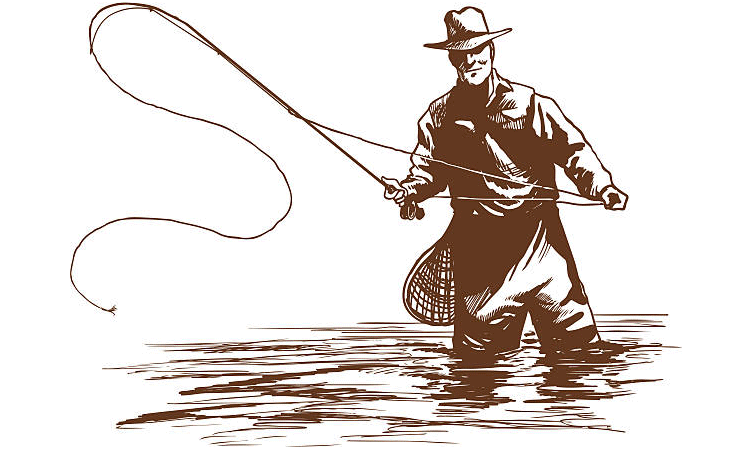
Fly Fishing and Metal Detecting, How To Use Your Silver As Bait
My father leaned in, he is still the best storyteller I know. He began to explain to me how an old timer fisherman was an absolute genius at catching fish, and it all had to do with customizing his bait. Today I am still fishing, but this time it's for treasure, and I realized how to use my silver dimes from previous hunts as the bait!
Every summer my family would go to Canada, usually Nova Scotia, Cape Breton Island region. My father is notorious for overloading the van with gadgets and gear. So my three siblings and I would have to lay on mountains of equipment in the back of the van, and we loved it. After all, what squirmy adventurous kid likes car seats?
We would go on hikes to majestic waterfalls utterly free of any trace of mankind. We would hunt for fossils and rocks on roadside embankments and eroding beach cliffs that looked like they could be right out of a movie. It didn't matter what we were searching for, it was all treasure in my eyes.

When we hiked on a river, I would run full speed ahead with my fly fishing rod, so I could have extra time at the hole to catch delicious fresh trout. We would bring our finds back to a log cabin which resided on an old apple orchard. There my father would sit back under a perfect summer breeze and tell us stories.
My father spoke of an old fly fisherman he knew, who every morning before the sun had even risen would head out to a stream to catch his dinner. The fisherman would do two important things:
He looked at what insects were flying around in the air, and landing on the water.
He would then choose or tie a fly that resembled that insect and start fishing.
Once he caught his first fish, the fly fisherman would open that fish up, and look at the contents of its stomach. Then, and only then, did he truly know what the fish were biting that morning.
Once he knew what kind bait to use, he tied a very special customized fly to resemble that insect.
From then on, it all came down to his technique, and since he had a masterful cast, the fisherman would catch as many fish as he needed for that day.
With each new river or stream, and each new day, the fisherman used the same technique to customize his fishing approach.
How on earth does this apply to metal detecting you ask?
Now 36 years old, I metal detect with the same impatience and ambition that I had when I was younger. Carrying my new Minelab Equinox 800 in hand, I headed to a very difficult, highly mineralized, and trashy old park that I've hunted many times before with other metal detectors.

Of course, being impatient, I tried to run the Equinox 800 hot. With my setting on zero discrimination, nothing notched out, recovery speed 2, 2-tone, iron audio on, no iron bias, sensitivity at 20, Park 2, multi-frequency.
It was a nightmare. There were so many sounds my brain hurt, and I was hunting in 2-tones! It wasn't the detectors fault, the Equinox 800 is a surgical machine, and was just doing its job. Especially in multi-frequency, the Equinox 800 will report every little metal object in the highly mineralized ground, and for this hunting environment, that was too much.
The Epiphany
I persevered, digging the tiniest scraps of foil, deep iron, and trash. Finally, after 4- hours of trying to pick out good targets from the turmoil of sounds, my mind began to wander. I thought of the story of the fisherman that my father told, and that's when it clicked. I pulled a silver dime I had found from another site out of my pocket and buried it 10-11" inches deep.
I swept over the dime with the Equinox 800, it was faint, and the detector was just barely picking it up. I went through every setting I could think of, but the soil was just too mineralized and junky. Finally I looked over at the frequency button. I switched to 5kHz frequency. Boom! The chatter went away, the dime sounded cleaner. I pushed 10kHz, did a ground balance. Blam! The dime sounded deep but crystal clear, there was zero EMI, and zero ground noise! Now I pushed 15kHz, and still hit it clearly, then I started to lose it a little at 20kHZ.
I was exhausted but grinning. There was inspiration in my step now, I felt like I had a new secret weapon for this relentlessly noisy site. I gave it another 1/2hr of detecting and found a silver war nickel and a wheat penny. The ground was as clear as day.
The Secret
If you haven't read the message yet, here is the secret. Every hunting site is going to be different, just like every river and stream are different. How do we find out exactly what to listen for when we visit each new metal detecting site?
Bring with you whatever treasure you expect to find, and bury it in the ground. Then swing your coil over the target and customize your detector to hear that signal as clearly as possible. This technique could be compared to the old fly fisherman custom-tying his fly's to each fishing site once he knew what was in the belly of the fish.
Every metal detector is a powerful tool, but if you treat your detector like a one-setting-fit's-all-detecting-sites, you will be sorely let down and miss many great finds.
Instead, think strategically like a fisherman. Examine your site. Find out how mineralized the soil is by doing a manual ground balance (never use auto tracking). Bury gold, silver, copper, or whatever you're hunting for, and listen to what it sounds like under various settings.
Does lowering the sensitivity help? How about using more or less discrimination? Bury your target next to a rusty nail, what happens? Try different frequencies! Multi-frequency is a very powerful tool but this story proves that every frequency has its place. If you don't have a multi-frequency detector, make sure to get one or two single-frequency detectors that you think will best suit the soil conditions you'll be hunting in.
So if you're experience a lot of EMI or ground noise and not getting anywhere, you might just want to try tying a new fly on, and giving it a spin.

